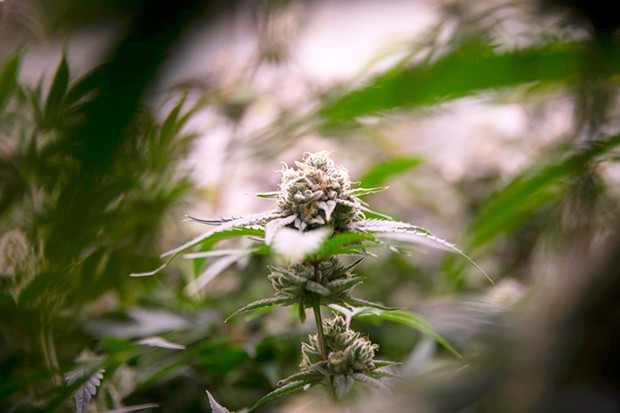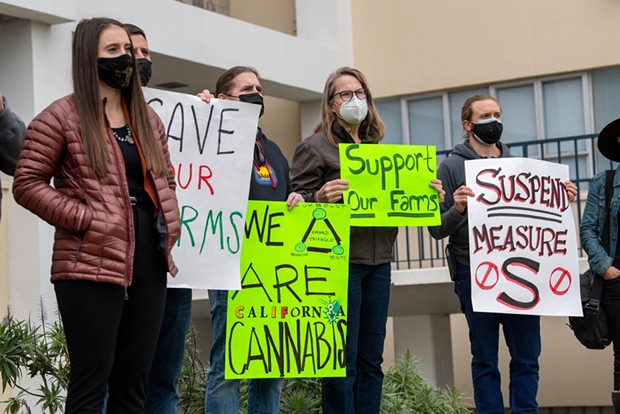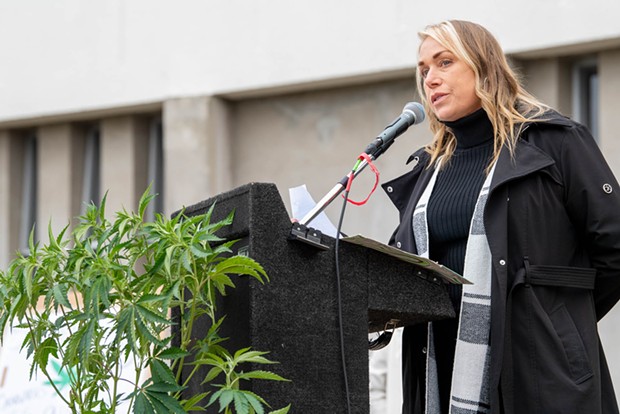An Industry on Edge
Reform initiative headed for ballot would dramatically overhaul cannabis regulation in Humboldt
By Thadeus Greenson [email protected] @ThadeusGreenson
Miguel Gutierrez Jr., CalMatters
The Cannabis Reform Initiative is slated to go before voters March 5, 2024, and if passed would overhaul the county's commercial cannabis cultivation regulations.
[
{
"name": "Top Stories Video Pair",
"insertPoint": "7",
"component": "17087298",
"parentWrapperClass": "fdn-ads-inline-content-block",
"requiredCountToDisplay": "1"
}
]
The Humboldt County cannabis industry is on edge, with an initiative slated to come before voters next year that would dramatically reshape cultivation regulations, capping the number and limiting the size of farms, and overhauling how the county's primary cash crop can be grown moving forward.
More than four dozen cannabis farmers and industry advocates addressed the Humboldt County Board of Supervisors on March 7 to warn of what they see as the catastrophic consequences the initiative would have, pleading with the board to publicly oppose the measure, which has qualified to be on the March 5, 2024, ballot. Speaker after speaker decried the initiative, describing it as everything from "anti-cannabis" and "anti-community" to the work of "economic terrorists" and, perhaps most antagonistically, "the Karen Initiative."
"Do we want Humboldt to be just another part of rural America — bleak, devastated?" one speaker asked. "That's what you get with the Karen Initiative."
Initiated by a group of Kneeland area residents concerned about the environmental and neighborhood impacts of cannabis cultivation, the measure is shaping up to be one of the more contentious and divisive in recent memory. Signature gatherers for the initiative said they faced organized harassment while gathering the more than 7,000 signatures collected to qualify it for the ballot, while some who say they signed on to support the measure now say they were misled to think it was designed to protect the county's small farms.
After hearing speaker after speaker at the March 7 meeting decry the initiative, and receiving an alarming analysis from county staff that warned of "dire consequences" for both the industry and the planning department should it pass into law, the Board of Supervisors voted to form an ad hoc committee to meet with the initiative's proponents to see if a compromise can be reached to withdraw it. Fourth District Supervisor Natalie Arroyo, Second District Supervisor Michelle Bushnell and Planning Director John Ford are now slated to meet with the proponents in the coming weeks to start that conversation. But, in a letter to the board, one of the initiative's authors indicated such an accord is unlikely, as the group feels an obligation to the measure's 7,000 signees to move forward. It should also be noted that if passed, the initiative could only be amended or altered by another vote of the people.
The initiative's primary author, Mark Thurmond, declined to comment for this story when reached by the Journal, saying its proponents want to wait to speak with the ad hoc committee before responding publicly.
As the industry waits on proverbial pins and needles to hear the outcome of that meeting and contemplates next steps, we take a look at the current state of cannabis regulation in Humboldt and how it would change should the initiative be voted into law.
As it Stands
Once home to an estimated 15,000 cannabis farms, Humboldt County is now home to 1,027 active permitted farms, while the Humboldt County Sheriff's Office estimates another 1,000 are operating illicitly, primarily growing cannabis indoors to be sold illegally out of state. Of those with active permits, 739 are for pre-existing farms — meaning they were actively cultivated prior to obtaining permits — and 210 are new, with another 78 comprising a mix of the two.
The majority of these active permits are for farms cultivating less than 10,000 square feet of cannabis, with 189 ranging in size from a half-acre to an acre and 19 cultivating more than 1 acre of cannabis.
What constitutes a large-scale farm or a mega grow is in the eye of the beholder. While many have affixed the term to anything spanning an acre or more, the county staff report notes the largest farms in Humboldt County — ranging between 7 and 8 acres — are far shy of the 100-plus acre farms permitted in Santa Barbara and San Bernardino counties, or even the 60-plus acre farms closer to home in Lake County.
While there is certainly some disagreement about the adequacy of controls, applicants for cultivation permits have to show their farms' access roads are serviceable, that most neighborhood impacts will be mitigated and that the farms' water will be sourced in a way that won't negatively harm the environment — usually through rainwater catchment and storage systems and ground wells. In the case of ground wells, the county requires a geologic study to determine if they will impact nearby streams and rivers, or neighbors.
Permitted farms also continue to be monitored by the county for permit compliance, as well as state agencies, and the county staff report notes the Planning Department conducted more than 900 site inspections in 2022, as well as more than 400 "remote inspections," with some overlap between the two.
Combined with the changing market forces brought by full-scale legalization, the county's regulatory framework — which has evolved from an initial commercial medical cannabis land use ordinance passed in 2016 to one governing both medical and recreational commercial cultivation in 2018, which was further tweaked in 2020 — has unquestionably reduced the collective footprint of the industry in Humboldt. Regulation has also changed the nature and impacts of cannabis cultivation in Humboldt, weeding out most of the most egregious environmental damage and concentrating farms in certain areas, as the county's land use ordinances aimed, in part, to move cultivation out of the areas where it was deemed likely to cause the most environmental damage and onto land deemed better suited for farming.
The county staff report notes that areas with what's deemed prime agricultural land — communities like Honeydew, Shively and Holmes Flat in Southern Humboldt — have attracted concentrations of permitted farms, bringing neighborhood impacts that have frustrated some residents. A couple larger cannabis farms — particularly a 5.73-acre grow on a 7,000-acre property known as Rolling Meadows and a proposed 22-acre grow in the Arcata Bottoms that was reduced to 5.7 acres — have also drawn a lot of community concern and attention, the report notes.
Few seem fully happy with the current lay of the land. Farmers have repeatedly complained of the costs of permitting and compliance — especially amid an oversaturated cannabis wholesale market that has sent prices plummeting and what they deem high state and local tax rates — noting that geologic and hydrological studies cost money, as do water storage systems and road improvements. Environmental groups, meanwhile, seem to feel that regulation has curtailed many of the most egregious abuses, though oversight is laxer than they would like and they have ongoing concerns about the permitting of new farms in outlying, off-the-grid areas, generator use and the lack of comprehensive studies on groundwater draws and their cumulative impacts.
The Initiative
Distressed by an application to permit a more than 40,000-square-foot grow on Barry Ridge, a group of Kneeland residents convened a community meeting, worried about the impact the farm and others would have on everything from traffic and water resources to the elementary school. About 100 people attended, and several — including the initiative's chief proponents — walked away deeply concerned the county was permitting too many farms and exercising too little oversight.
They soon met with people from other areas of the county who had similar concerns and personally financed the effort to draft the reform initiative and then volunteered their time over the span of months to gather enough signatures to qualify it for the ballot.
If passed, the 38-page initiative would modify the county's General Plan — considering the guiding document for all county land use planning — to dramatically alter the cannabis cultivation permitting landscape in Humboldt. The fact that the initiative would amend the General Plan is noteworthy, as it would also then require the county to modify any codes or regulations deemed in conflict with the initiative so they align.
Perhaps most notably, the initiative would cap the size of cannabis farms at 10,000 square feet, which would immediately render more than 400 permitted farms "non-conforming." Additionally, the initiative would require farms be located on roads that meet or exceed Category 4 standards (two-lane roads that can accommodate speeds of 25 to 40 mph, according to the county website), that those using artificial light only use low-wattage lighting systems to reduce climate impacts and phase out of the use of generators to the point they will ultimately be allowed for emergency use only. It would also extend the forbearance period — the part of the year when farmers with water rights are prohibited from drawing surface water from streams and rivers — and require additional studies of groundwater impacts. The initiative would also cap the total number of cannabis permits allowable in the county to 1.05 times the number issued as of March 4, 2022 (the day the initiative was certified to begin signature gathering), which would equate to 978 permits, according to the county staff report.
Under the initiative, cultivation permits would also expire annually, requiring farmers to reapply, while the planning department would be required to conduct on-site inspections annually for every permit and broadly increase public noticing efforts for every permit application. While the initiative specifies it would require public hearings for permits for all grows larger than 3,000 square feet, it is ambiguous whether this would apply for renewal applications, as the initiative doesn't describe a renewal process, but the prospect of holding 1,000 or so public hearings for permit renewals annually seems logistically untenable.
The initiative also includes a provision that states "no approval of a permit for commercial cannabis cultivation" would be allowed that results in "any one person holding more than one active permit." It's ambiguous whether that would simply limit the number of cultivation permits a single person can hold or should be interpreted to prevent a cultivation permit holder from also holding a tourism or processing permit, a point of significant concern for the industry. It's again important to note the initiative cannot be changed or amended from the form that was circulated for signatures and, if passed, could only be changed through another election.
If passed, between its cap on the size and number of farms and the number of permits an individual can hold, road requirements and limitations on the use of artificial light, the initiative would immediately render most of the county's farms "non-conforming," meaning that while they met the requirements at the time of permitting they are not in compliance with current regulations. The initiative would allow these farms to stay in operation as long as they don't "expand" their uses — which is defined to mean "an increase in cultivation area, water usage, energy usage, or the number or size of any structures used in connection with cultivation" — or apply for another permit.
There are unanswered questions about whether simply applying to renew one's permit, as required by the initiative, would constitute a new permit application that would require a non-conforming farm to come into compliance with the letter of the initiative. If that's the case, it would require swaths of the county's farm to reduce their footprints after a year. It's also unclear whether environmental improvements — like adding water storage capacity or a solar array — would fit the definition of an expanded use and thus force a non-conforming farm to come into compliance.
If the initiative passes, county planners would be put in the position of reconciling these ambiguities, with the potential that their determinations would then be challenged in court, whether by an unhappy cultivator or a disgruntled neighbor. From farmers to environmental groups to county staff, many have said they see implantation of the initiative, if passed, to be rife for legal challenges.
The initiative would also inherently leave some currently in the process of pursuing cultivation permits behind. It allows the county to continue processing all applications that were complete by March 4, 2022, but the processing of all permits received after would halt until the number of permitted farms falls below the cap set by the initiative. This would leave some applications pending indefinitely. Ford, the planning director, also noted this would mean some farmers who voluntarily participated in the county's "Retirement, Remediation and Relocation Program" — which allowed existing farms in environmentally unsuitable areas to retire their grows and remediate the land in exchange for a promise they would be allowed to relocate them to more suitable agricultural land — would be left out.
The initiative itself makes clear its primary concern is the environment, not the industry, farmers or the county.
"The purpose of this Humboldt Cannabis Reform Initiative is to protect the county's residents and natural environment from harm caused by large-scale cannabis cultivation," it states. "Specifically, the initiative seeks to promote environmentally responsible cultivation practices and support watershed health for residents, property owners and ecosystems affected by cannabis cultivation activities. This initiative accomplishes its purpose by limiting the number, type and acreage of permits for commercial cannabis cultivation ...."
Enviros' View
While most of Humboldt County's environmental organizations have yet to take an official stance on the initiative, there seems to be consensus that the current regulatory framework needs to be improved and the initiative constitutes a significant overhaul of a complex industry.
"At least on the environmental side, there are things we've always wanted to have cleaned up," said Environmental Protection Information Center Executive Director Tom Wheeler, specifically pointing to a "loophole" that allows permitting of farms on prime agricultural soil even if it's in remote, off-the-grid areas, the pervasive use of generators and the need for a more thorough analysis of the cumulative hydrological impacts of wells.
Caroline Griffith, the executive director of the Northcoast Environmental Center, agreed current regulations need work, saying she does see a "kind of bias" toward "large, industrial" grows, which she would define as anything larger than an acre. Griffith also pointed to the continued permitting of farms in remote, off-the-grid areas, which require employee commutes and, often, generator use, adding to cumulative impacts.
"We share a lot of the same concerns" as the initiative's writers, Griffith said, though she noted the NEC has not taken a stance on the initiative despite months of internal discussion. "The reason we have not is because it is really such a complex issue that it's hard to address it with an initiative."
Griffith said she personally hopes the initiative might push the county to revamp its cannabis land use ordinance for a third time.
"The thing I would like to stress is there are a lot of people from all different sides who see issues with the state of our current ordinance and where it stands," she said.
Ultimately, the initiative's official proponents are the only ones who can pull it from the 2024 ballot, and it remains to be seen if they are willing to do so. If not, there's talk from the industry and officials of trying to put forward a competing ballot initiative, though what that might look like is anyone's guess at this point.
Wheeler, whose EPIC has officially come out opposing the initiative, said the petitioners are absolutely right in recognizing there are real environmental inadequacies in the county's existing framework and seeking to address them. But the issues involved are extraordinarily complex, he said, and a more collaborative process is required to adequately address them.
"I would like to see revisions to the county's ordinance, or new ordinances, come by the same way as the old ones, which was through that grueling, exhausting process where there are tradeoffs and we work together," he said. "I just think that's a better way of making laws."
Thadeus Greenson (he/him) is the news editor at the Journal. Reach him at (707) 442-1400, extension 321, or [email protected].
Comments
Showing 1-1 of 1
more from the author
-
Court Rejects Zoellner Appeal
- Jun 28, 2024
-
Change of Plea Hearing Set in Fair Embezzlement Case
- Jun 27, 2024
-
Journal Welcomes California Local News Fellows
- Jun 27, 2024
- More »
Latest in News
Readers also liked…
-
Through Mark Larson's Lens
A local photographer's favorite images of 2022 in Humboldt
- Jan 5, 2023
-
'To Celebrate Our Sovereignty'
Yurok Tribe to host gathering honoring 'ultimate river warrior' on the anniversary of the U.S. Supreme Court ruling that changed everything
- Jun 8, 2023

































